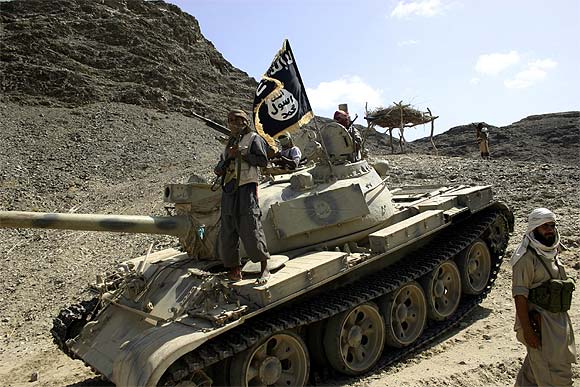
If a new leader emerges who is able to rally Al Qaeda cadres around and motivate them to act, we may still face new acts of mass casualty terrorism, warns B Raman
A year after the death of Osama bin Laden at the hands of the United States Navy Seals at Abbottabad in Pakistan, the central command and control of Al Qaeda based in Pakistan continues to be in a state of disarray.
It has not been able to recover from the severe leadership losses inflicted on it by US drone strikes after the death of Osama. The lack-lustre leadership of Ayman al-Zawahiri, the new Amir of Al Qaeda, who is also believed to be operating from hide-outs in Pakistan, has not been able to restore the motivation of its central command and control.
The disruption of its central command and control appears to have affected its ability to plan and launch catastrophic terrorist strikes in faraway places like the US.
But its affiliates like the Taliban outfits in Pakistan and Afghanistan, the Haqqani Network of Afghanistan, the Lashkar-e-Tayiba and the Lashkar-e-Jhangvi of Pakistan, Al Qaeda in the Arabian Peninsula, based in Yemen; Al Qaeda in the Islamic Maghreb, based in Algeria and Mali; al Shabaab of Somalia; and Boko Haram of Nigeria have maintained their capability for sporadic acts of terrorism involving mass fatalities in their respective areas of operation.
Click on NEXT for more...

While the global reach of Al Qaeda has been affected due to the inability of its present leadership to plan and carry out terrorist strikes on a global scale, its regional command and control, regional cadres and regional ability to carry out strikes remain unimpaired.
The affiliates of Al Qaeda continue to use the multi-modus operandi and multi-target operations that they had learnt from Al Qaeda. This was evident from the recent commando style attacks on different targets in Afghanistan by the Afghan Taliban and the Haqqani Network.
Mass casualty terrorist attacks carried out during the last one year by affiliates of Al Qaeda in Yemen and Nigeria highlights their continuing motivation and ability to strike when an opportunity presents itself.
Osama's death has not only weakened the lethality of the central command and control, it has also blunted its net-based PSYWAR campaign on which Al Qaeda was dependent for winning new recruits, imparting online training and disseminating online instructions. As a result, there has been a decline in the flow of Arab recruits with a capability for global attacks and in attacks launched by net-motivated 'lone wolf' jihadis.
Click on NEXT for more...

There are also indications that after the death of Osama, who was a Saudi of Yemeni origin with influential family connections in Saudi Arabia, there has been a decline in the flow of funds to Al Qaeda from so-called charity organisations and affluent Saudi families. The shortages caused by this decline have not been made good by the money earned from narcotics smuggling.
The weakening of Al Qaeda as a global terrorist organisation does not mean that dangers of a catastrophic or mass casualty act of terrorism of the kind practised by the outfit before the death of Osama is any less now. The dangers will remain unless intelligence agencies across the world are able to identify and neutralise the operatives of Al Qaeda, who had been trained and placed in sleeper cells in different parts of the world by Osama when he was alive.
The central command and control of Al Qaeda has been disrupted, but not its global network of sleeper cells. If a new leader emerges who is able to rally them around and motivate them to act, we may still face new acts of mass casualty terrorism.
As long as Al Qaeda's global network of sleeper cells is not disrupted, dangers of maritime terrorism, acts involving weapons of mass destruction and mass disruption of the internet have to be guarded against through international co-operation in intelligence collection and sharing and physical security.
Click on NEXT for more...

The 9/11 strikes by Al Qaeda in the US led to a decade of close international co-operation against global terrorism. We cannot afford to let this co-operation weaken till the Al Qaeda is decimated beyond recovery. Al Qaeda has presently been weakened, but not decimated.
India has to maintain a high state of vigilance and preparedness against commando-style, complex terrorist strikes of the kind launched by the Lashkar-e-Tayiba in Mumbai on 26/11 and by the Afghan Taliban in Afghanistan recently.
The LeT has not repeated its 26/11 style terrorist strikes in Indian territory after 2008. But its training camps in Pakistani territory have been as active as ever and the anti-India radicalisation of its leadership shows no signs of abating.
There are no indications of any change in the use of terrorism as a strategic weapon against India by Pakistan's Inter-Services Intelligence.
If the US and other North Atlantic Treaty Organisation forces carry out their plans to thin out their presence in Afghanistan in the coming months, the US is expected to transfer its holdings of arms and ammunition to the Afghan Security Forces. There will be dangers of their transfer to some of them into the hands of jihadi terrorist groups in the Af-Pak region.
Click on NEXT for more...

With the thinning down of NATO presence, the jihadi terrorist organisations now operating in Afghanistan will find at their disposal surplus jihadis who are well-trained and motivated. India has to be prepared to the possibility of some of these cadres and weapons being diverted to Pakistan-occupied-Kashmir to re-kindle terrorism and the Pakistan-sponsored proxy war in Jammu & Kashmir.
At a time when there is an urgent need to revamp our intelligence collection, follow-up action and physical security capabilities through close co-operation between the central agencies and the state police and through fresh instruments such as the proposed National Counter-Terrorism Centre, it is worrying that the differences between the Centre and the states on the NCTC are threatening to come in the way of the exercise to strengthen our counter-terrorism capability.
Stability in the Af-Pak region is years away. Till a modicum of stability is established, the Federally-Administered Tribal Areas of Pakistan will continue to be the epi-centre of the attempts to revive global terrorism and to keep India bleeding. The international community -- and particularly India and the US, which face the maximum threats from the terrorists based in the Af-Pak region -- cannot afford to slacken their vigilance.
Click on NEXT for more...
...